A Wayland, Mass. man was felled by a piece of ice as big as a desk this weekend when he was trying to clear an ice dam from his roof. This winter’s weather has created a perfect storm for ice dams—a ridge of ice that builds up along the edge of a roof trapping melting snow and causing water to leak into the home. “The heavy snow followed by days of cold weather across much of the northern U.S. has created perfect conditions for ice damming, and it’s no surprise this has been a record year for them,” says Tom Bullnow, senior director of technical services for the National Roofing Contractors Association.
Ice dams are formed when the sun and heat from the attic melt snow on the upper parts of the roof. The melt water pools above the dam and over time, works its way between the roof shingles and into your home. Because the ice dam sits over the unheated eaves, it doesn’t melt as fast as the snow on the roof. In addition to water damage, the dams can rip off gutters and cause damage to the roof itself. (The University of Minnesota illustrates how they form.)
What to do now
If you see water pooling on your floors or windowsills or leaking from the ceiling, go outside and make a visual inspection of your roof. If you see ridges of ice below piles of snow, an ice dam may be the reason for the leaks. Don’t try to remove the ice dam yourself—few things are as dangerous as working on a ladder resting against an icy gutter. You’ll need to call a professional roofer. “They know how to reach every part of the roof safely and know how to use rubber mallets and roof rakes that won’t damage the roofing or gutters,” says Bullnow. “They also have insurance and workman’s compensation, unlike many regular handymen.”
Removal costs depend on how large and accessible your ice dams are, but most roofers will charge $100 an hour for this kind of hazardous work. You can also call specialists who will spray the dams with low-pressure steam to melt the ice. “We generally charge $225 an hour, and we can do the average house in one to four hours, depending on how thick the ice is and how cold the temperature is outside,” says Allan Dou, marketing manager for Hustad Roofing in Hudson, Wisconsin.
If your ceiling or walls have been damaged, don’t attempt any repairs until they dry out. You’ll also want to address the heat loss problem that caused the ice dam in the first place.
What to do later
Once the weather warms up, you can take corrective action for next season. Roofing experts stress that the best way to handle ice dams is to insulate and ventilate your attic to minimize the differences in temperature that cause the dams to form. You may want to consult a weatherization contractor who can help you locate the areas of greatest heat loss and recommend how to fix them.
Both the Department of Energy and Consumer Reports offer step-by-step instructions for do-it-yourselfers who want to tackle the job themselves. But if your home has a history of ice dams, or if you have ducts or recessed lighting fixtures that extend through the ceiling into the attic, you may want to leave the job to the pros.
Article Source: Consumer Reports Home and Garden Blog

